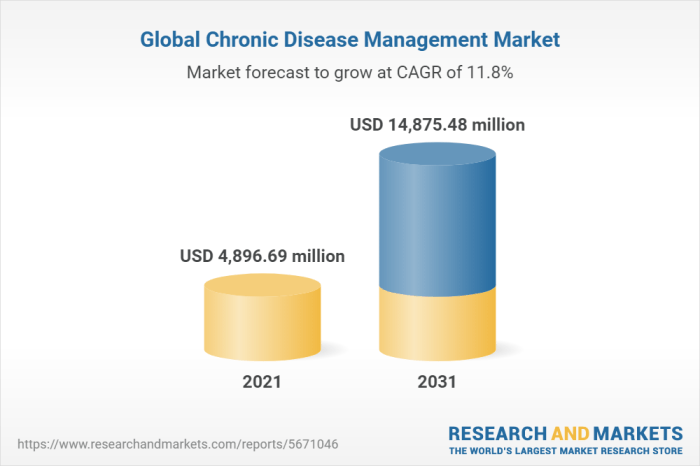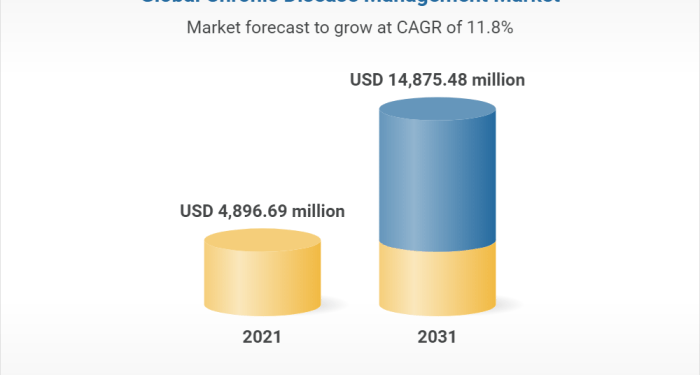With Global Trends in Chronic Disease Management at the forefront, this paragraph opens a window to an amazing start and intrigue, inviting readers to embark on a storytelling journey filled with unexpected twists and insights. Chronic diseases impact healthcare systems globally, and keeping up with the latest trends in managing these conditions is crucial.
Let's explore how these global trends are reshaping the way healthcare providers approach chronic disease management.
Overview of Global Trends in Chronic Disease Management

Chronic diseases, such as heart disease, diabetes, and cancer, have become a significant burden on global healthcare systems due to their long-term nature and high prevalence. These conditions not only affect the quality of life of individuals but also put a strain on healthcare resources and budgets worldwide.Staying up-to-date with trends in managing chronic conditions is crucial for healthcare providers to ensure they can deliver the best possible care to patients.
As research and technology continue to advance, new strategies and treatments are constantly being developed to improve outcomes and enhance patient well-being.Global trends play a crucial role in shaping the way healthcare providers approach chronic disease management. By understanding patterns and developments on a global scale, providers can adopt innovative approaches, implement best practices, and tailor treatments to meet the diverse needs of patients from different regions and backgrounds.
Technology Advancements in Chronic Disease Management
Technology has played a significant role in revolutionizing the management of chronic diseases worldwide. From advanced telemedicine solutions to wearable devices and health apps, the integration of technology has transformed the way patients receive care and manage their conditions.
Telemedicine
Telemedicine allows healthcare providers to remotely diagnose, monitor, and treat patients with chronic diseases. Through virtual consultations and remote monitoring tools, patients can access healthcare services without the need for in-person visits. This not only improves convenience for patients but also enables better disease management and early intervention.
Wearable Devices
Wearable devices, such as smartwatches and fitness trackers, have become increasingly popular in chronic disease management. These devices can track vital signs, activity levels, and other health metrics in real-time, providing valuable data to both patients and healthcare providers. By continuously monitoring health parameters, wearable devices help individuals stay proactive in managing their chronic conditions.
Health Apps
Health apps have become valuable tools for chronic disease management, offering features like medication reminders, symptom tracking, and virtual coaching. These apps empower patients to take control of their health by providing personalized insights and recommendations. Additionally, health apps can facilitate communication between patients and healthcare providers, ensuring timely interventions and adjustments to treatment plans.
Benefits and Challenges
The integration of technology into chronic disease care comes with various benefits, including improved access to healthcare, enhanced patient engagement, and better disease monitoring. However, challenges such as data privacy concerns, digital divide issues, and the need for healthcare professionals to adapt to new technologies must be addressed.
Overall, the benefits of leveraging technology in chronic disease management outweigh the challenges, paving the way for more efficient and patient-centered care.
Patient-Centered Approaches in Chronic Disease Management
Patient-centered care in managing chronic diseases has become a pivotal focus in healthcare systems worldwide. This approach emphasizes the importance of involving patients in decision-making processes, treatment plans, and overall management of their chronic conditions. By shifting the focus towards the needs, preferences, and goals of the patient, healthcare providers aim to improve outcomes and enhance the quality of care provided.
Involving Patients in Decision-Making
Patient-centered approaches involve actively engaging patients in decision-making regarding their treatment plans. Healthcare providers work collaboratively with patients to ensure that their preferences, values, and goals are taken into consideration when determining the most suitable course of action. This may involve discussing various treatment options, potential side effects, and long-term implications with the patient to make informed decisions together.
Impact of Patient Engagement
Patient engagement has shown to have a significant impact on the outcomes of chronic disease management. When patients are actively involved in their care, they tend to have better adherence to treatment plans, leading to improved health outcomes. Additionally, patient engagement can enhance communication between healthcare providers and patients, resulting in a more holistic and effective approach to managing chronic diseases.
Ultimately, patient-centered care empowers individuals to take control of their health and well-being, leading to better overall health outcomes.
Global Initiatives and Policies for Chronic Disease Management
Global initiatives and policies play a crucial role in addressing the growing burden of chronic diseases worldwide. Different countries have implemented various strategies to combat these conditions effectively. Let's explore some key initiatives and policies and analyze their impact on chronic disease management.
Regional Approaches to Chronic Disease Management
- Europe: The European Union has focused on prevention strategies, promoting healthy lifestyles, and investing in research and innovation to tackle chronic diseases such as cardiovascular diseases and cancer.
- Asia: Countries like Japan and Singapore have implemented universal healthcare systems and preventive measures to manage chronic conditions like diabetes and hypertension.
- North America: The United States has emphasized personalized medicine, digital health solutions, and public health campaigns to address chronic diseases like obesity and diabetes.
- Africa: Many African countries have prioritized primary healthcare services, community outreach programs, and disease surveillance to manage conditions such as HIV/AIDS and malaria.
Effectiveness of Global Strategies in Chronic Disease Management
- Collaboration: Global initiatives like the World Health Organization's Global Action Plan for the Prevention and Control of Noncommunicable Diseases have encouraged collaboration between countries to share best practices and resources.
- Evidence-Based Interventions: Policies based on scientific evidence and research have shown promising results in reducing the prevalence of chronic diseases and improving health outcomes globally.
- Health Equity: Efforts to promote health equity and access to healthcare services for all populations have been essential in addressing disparities in chronic disease management across different regions.
- Monitoring and Evaluation: Regular monitoring and evaluation of policy implementations have helped countries assess the effectiveness of their strategies and make necessary adjustments to achieve better outcomes in chronic disease management.
Epilogue
In conclusion, Global Trends in Chronic Disease Management offer a glimpse into the future of healthcare, where technology, patient-centered care, and global initiatives play a pivotal role in addressing the challenges posed by chronic diseases. By staying informed and adapting to these trends, we can work towards better outcomes and a healthier world.
FAQ Section
How do global trends impact chronic disease management?
Global trends influence the strategies and approaches used by healthcare providers to manage chronic conditions, leading to improved outcomes and patient care.
What role does technology play in managing chronic diseases?
Technology advancements such as telemedicine, wearable devices, and health apps are revolutionizing chronic disease management by enabling remote monitoring and enhancing patient engagement.
Why is patient-centered care important in chronic disease management?
Patient-centered care ensures that patients are actively involved in decision-making and treatment plans, leading to better adherence and outcomes in managing chronic diseases.
How effective are global initiatives in combating chronic conditions?
Global initiatives and policies play a crucial role in addressing the rising burden of chronic diseases by implementing strategies that promote prevention, early detection, and improved treatment outcomes.




